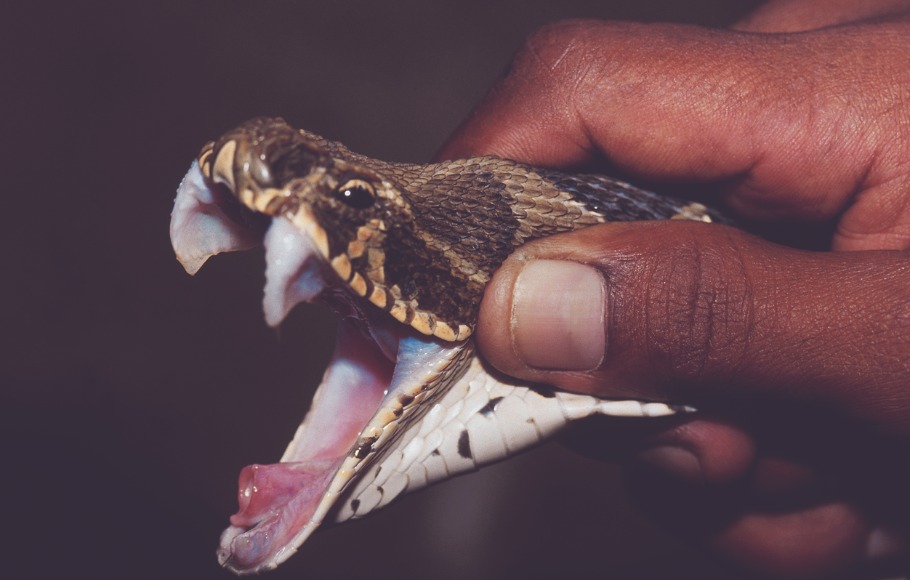
Snakebites highest in India, anti-venoms largely ineffective
According to the World Health Organisation (WHO), around 1.5 lakh cases of snakebite deaths are witnessed every year across the world. Of this, India accounts for nearly one third of the total deaths, claimed Dr Sakthivel Vaiyapuri, associate professor, venom pharmacology, University of Reading, UK, quoting a report by the health agency.

That India is a land of snake-charmers may be ignored as a wrong perception to the world, but data reveals the country accounts for nearly 50,000 deaths every year due to snakebite.
According to the World Health Organisation (WHO), around 1.5 lakh cases of snakebite deaths are witnessed every year across the world. Of this, India accounts for nearly one third of the total deaths, claimed Dr Sakthivel Vaiyapuri, associate professor, venom pharmacology, University of Reading, UK, quoting a report by the health agency.
Dr Vaiyapuri, who conducted a pilot household survey in Tamil Nadu on this topic, said nearly 10,000 people are likely to die every year in the state due to snakebite. The study was carried out in 30 villages covering different geographical regions of the southern state in 2010.
Also read | Snake delays Ranji game between Vidarbha and Andhra
The study revealed farmers are highly vulnerable to be bitten by snakes since they spend a lot of time in the fields, he told The Federal. “We cannot pinpoint which part of the state records the most incidents of snakebites due to the lack of reliable and accurate data. But wherever agricultural activities are taking place, people there are more vulnerable to snakebites,” he said.
He blamed the lack of awareness for being the main reason behind such deaths. “People in rural areas still approach traditional healers and avail herbal medicines for snakebites. This results in further deterioration of their health and delays anti-venom treatment in hospitals” he said.
Russell’s viper: a threat in Tamil Nadu
The scientific community has categorised four major venomous snakes as the ‘Big Four’: Russell’s viper (Daboia russelii), Saw-scaled viper (Echis carinatus), Indian Cobra (Naja naja), and Common Krait (Bungarus caeruleus).
“In Tamil Nadu, approximately 70 per cent of snakebites are caused by Russell’s viper and 20 per cent by the Indian Cobra. 10 per cent cases are due to the bite of Common Krait. Death by a Saw-scaled viper is rare,” said Krishnagiri-based Dr C Soundara Raj, who has been treating snakebite victims for over 20 years.
While Russell’s vipers and Saw-scaled vipers are considered haemotoxic, where the snake’s venom mixes in the victims’ blood and causes bleeding-related complications, the other two snakes are considered neurotoxic, where the venom severely affects the nervous system.
Also read | Students lathi-charged in Kerala during protest over girl’s death by snakebite
“Russell’s vipers’ bites often exert nephrotoxicity which can cause renal failure. So, the earlier the victims are treated with a polyvalent anti-snake venom (ASV), more are the chances of preventing their kidneys from being affected,” he said. Instead of wasting time by applying traditional medicines and practising inappropriate first aid, he said the victim should be hospitalised immediately and be treated with an anti-venom along with other additional treatments.
“If bitten by a Russell’s viper, the victim should be hospitalised within two hours and in case of Cobra and Krait, the victims should be treated within at least one hour. Popular first aid practices like tying a tourniquet above the snakebite spot, cutting it with a non-sterile sharp knife and sucking blood out from there should be avoided. Also, victims should not panic after being bitten by the snake since an increase in pulse rate will help the venom spread across the body,” Soundara Raj said.
Venom detection kit in making

In most cases, valuable time is spent trying to corroborate the snakebite envenomation and in determining the snake that has bitten the victim. “Only experienced doctors can immediately ascertain which snake could have bitten a victim and what would be the clinical effects to decide on the treatment regime,” said Dr Soundara Raj. “Otherwise, doctors follow the routine ‘20 minute whole blood clotting time’ test to identify whether the victim has been envenomed. It is the only technique we have now and it doesn’t work in case of Krait bites.”
In order to corroborate snakebite envenomation and identify the snake, a team of experts including Dr Sakthivel Vaiyapuri and Dr Harry Williams of the University of Reading, Dr Stephen Paul Samuel from UK’s Queen Elizabeth Hospital and Dr C Soundara Raj of Krishnagiri’s TCR Multispecialty Hospital have developed a ‘venom detection kit’.
Also read | Demand for parrots as pets on the rise, species in peril
“Using this kit, even an inexperienced doctor in rural health centres can ascertain whether a person was really bitten by a snake and venom was injected in his body, what kind of snake has bitten, and whether the victim can develop haemotoxic or neurotoxic complications,” said Dr Vaiyapuri.
Based on that, he said the doctors can confidently administer three to five vials of polyvalent ASV in case of envenomation and refer them to government hospitals for tertiary care. “In cases of ‘dry bite’, where a venomous snake could have bitten the victim but not injected any venom, there is no need for anti-venom infusion. Within a year, the detection kit will be available in the Indian market” he said.
Decreasing efficacy of polyvalent anti-dote
The polyvalent anti-snake venom (ASV) must be administered when victims are bitten by only the ‘Big Four’ snakes. “It is produced with the help of venoms extracted from these four snakes. So, their efficacy will be more in bites caused by these four. The efficacy will be less in bites caused by other snakes such as Hump-nosed pit viper, Malabar pit viper and Bamboo pit viper, said Dr Soundara Raj.
But, he said many hospitals administer polyvalent ASV in other cases as well. “This should be avoided as we don’t have any data to confirm the efficacy of currently used ASV against snakes other than these ‘Big Four’,” he said.
Also read | Tamil Nadu headmaster photographs rare bird after 84 years

In India, snake venoms are extracted only at Irulas Snake Catchers Industrial Cooperative Society located at Vadanemmeli, near Chennai. From here, the venoms are supplied to different parts of the country for the production of ASV. But the efficacy of polyvalent ASV changes according to the snakes living in different regions, said Dr Vaiyapuri.
“The venom composition of the ‘Big Four’ snakes varies from one place to another. For example, the venom composition of a Russell’s viper found in Tamil Nadu might be different from that of the same species found in West Bengal. So, we need to have venom samples from different geographical locations of the country in order to produce effective ASV. At least, we need to have ‘Big Four’ snake specimens for each state to produce better ASV. That will be mostly sufficient since most of the snakebites are caused by them,” he added.
Need for chemical-based anti-venom
In Tamil Nadu, although snakebite treatment is covered under TN Chief Minister’s Comprehensive Health Insurance Scheme, victims are given only around ₹20,000 for the treatment. “However, the treatment costs can easily go up to ₹2 lakh based on the level of complications,” said Vaiyapuri.
“The costs will be based on how many ASV vials are given, which in turn is based on how much of venom has been injected into the victim’s body. It will also depend on what side effects the victims develop after being administered ASV, besides other complications. Add to these, if the victim dies or becomes disabled, the financial burden on the victim’s family will be significantly larger. So, snakebites not only cause deaths and disabilities, but also affect the socio-economic status of the vulnerable masses,” he added.
One vial of ASV costs around ₹600 and snakebite victims are usually administered around 20 to 30 vials. “In order to bring down the costs of ASV, we are in the process of developing chemical-based anti-dotes, which can be used even in non-hospital settings. But to have that kind of medicines, we need to wait at least another five to 10 years,” he said.

